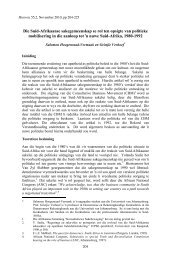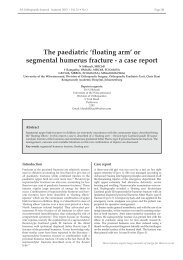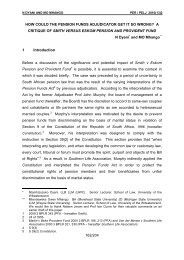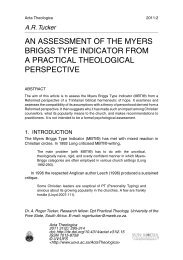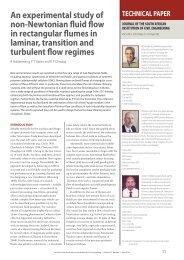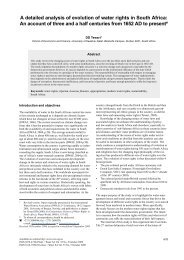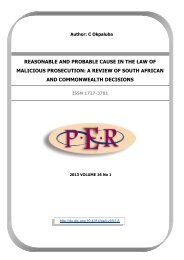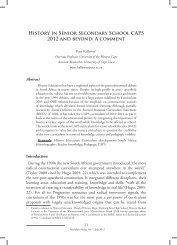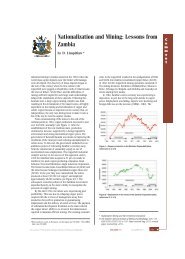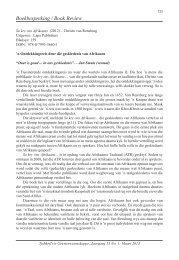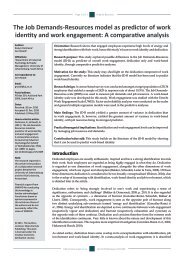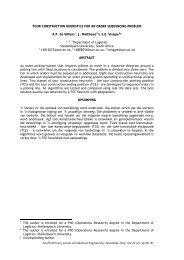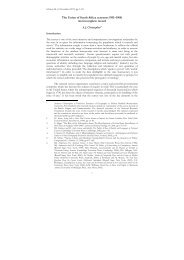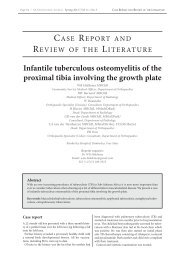Frances Baard's and Helen Joseph's struggle against apartheid ...
Frances Baard's and Helen Joseph's struggle against apartheid ...
Frances Baard's and Helen Joseph's struggle against apartheid ...
You also want an ePaper? Increase the reach of your titles
YUMPU automatically turns print PDFs into web optimized ePapers that Google loves.
Musiiwa - <strong>Frances</strong> Baard’s <strong>and</strong> <strong>Helen</strong> Joseph’s <strong>struggle</strong><br />
How it came to pass that we made our protest that day at the Union Buildings – the most<br />
hallowed seat of white government – is a small part, but nevertheless a part of the history<br />
of our country, South Africa. 19<br />
Both narratives carry a m<strong>and</strong>ate to fill a historical gap by telling a suppressed truth. As<br />
Schreiner explains, “The Nationalist [sic] government has attempted to suppress the<br />
truth <strong>and</strong> keep from us the real story of the people’s <strong>struggle</strong> for liberation. I hope that<br />
this book goes some way towards filling the gap.” 20 This truth that was deliberately<br />
repressed <strong>and</strong> was not captured in official documents, can be retrieved from women’s<br />
personal narratives. As Kathryn Anderson contends: “When women speak for<br />
themselves, they reveal hidden realities: new experiences <strong>and</strong> new perspectives emerge<br />
that challenge the ‘truths’ of official accounts …” 21 For Baard <strong>and</strong> Joseph, it is a truth<br />
that underscores women’s perception of their experiences of the <strong>struggle</strong> <strong>against</strong><br />
<strong>apartheid</strong>; the truth that the women’s anti-pass protest did not effect the phasing off of<br />
the pass law, but significantly realigned the policy <strong>and</strong> trajectory of the ANC. Not only<br />
does this truth emphasise the role of women, but it also redefines what finally came to<br />
constitute politics <strong>and</strong> how the political platform became gendered into both male <strong>and</strong><br />
female.<br />
Baard’s <strong>and</strong> Joseph’s narratives map out the trajectory of their experiences of the<br />
<strong>struggle</strong> <strong>against</strong> <strong>apartheid</strong> between the 1950s <strong>and</strong> the 1960s, yet they are marked with<br />
episodes of differences in unity. The first major difference is methodological, where<br />
Baard narrates her experiences of the <strong>struggle</strong> <strong>against</strong> <strong>apartheid</strong> to Schreiner, while<br />
Joseph writes an autobiographical recollection of her experiences of the same anti<strong>apartheid</strong><br />
<strong>struggle</strong>. The second issue is epistemological – to ascertain how the two<br />
women perceived their experiences of the <strong>struggle</strong> <strong>against</strong> <strong>apartheid</strong>.<br />
Methodological implications<br />
Definition<br />
L.C. Watson <strong>and</strong> M.B. Watson-Franke define personal narratives as<br />
a generic category including any expressive production of the individual that can be used<br />
to throw light on his view of himself, his life situation, or the state of the world as he<br />
underst<strong>and</strong>s it, at some particular point in time, or over the passage of time. 22<br />
Although they are retrospective personal accounts, life histories <strong>and</strong> autobiographies<br />
constitute different biographical genres. Watson <strong>and</strong> Watson-Franke define life history<br />
as, “any retrospective account by the individual of his/ her life in whole or part, in<br />
written or oral form, that has been elicited or prompted by another person”. 23 The whole life<br />
course is seen from the point of view of the person as she is currently trying to make<br />
sense of her relationship to past events, <strong>and</strong> the experience is usually recorded in the first<br />
person. 24 Though elicited by the researcher in the case of Baard’s testimony, the<br />
19. Joseph, Side by Side, Part 1, Chapter 1, “Twenty Thous<strong>and</strong> we March”.<br />
20. Baard <strong>and</strong> Schreiner, My Spirit is Not Banned, “Introduction”.<br />
21. Anderson et al, “Beginning where we Are”, p 104.<br />
22. L.C. Watson <strong>and</strong> M.B. Watson-Franke, Interpreting Life Histories: An Autobiographical Inquiry<br />
(Rutgers, New Jersey, 1985), p 2 (emphasis original).<br />
23. Watson <strong>and</strong> Watson-Franke, Interpreting Life Histories, p 2 (emphasis original).<br />
24. Some scholars have used both the first person <strong>and</strong> the third person. See S. Geiger, TANU Women:<br />
Gender <strong>and</strong> Culture in the Making of Tanganyikan Nationalism, 1955–1965 (Heinemann, Portsmouth,<br />
69



